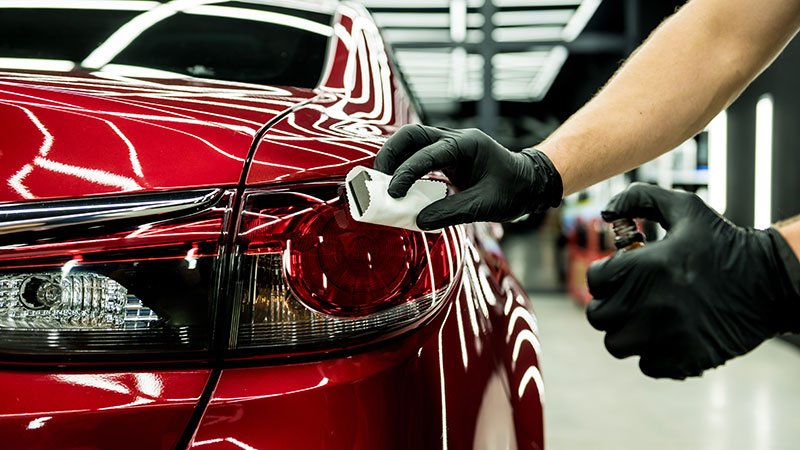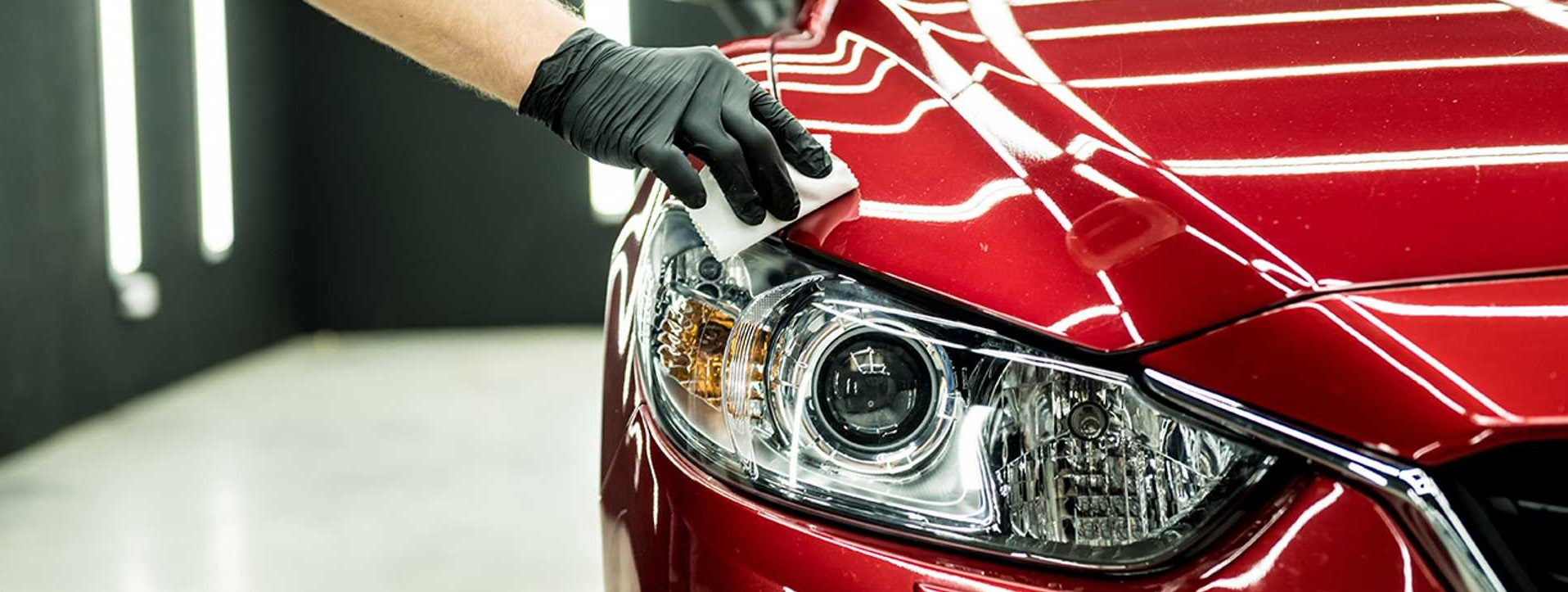Exploring the Science Behind Car Ceramic Coating and Its Protective Characteristics
The scientific research of car ceramic coating presents an interesting research study in advanced auto protection. Made up largely of silicon dioxide and polymers, these layers create a durable bond with automobile paint. This interaction boosts longevity versus ecological hazards while offering hydrophobic advantages. The ins and outs of just how these coatings job and their lasting advantages stay less recognized. Ceramic Coating Newark. Unloading these details exposes why ceramic finishings are ending up being a favored choice for lorry care
What Is Ceramic Coating?
Ceramic coating is a liquid polymer that chemically bonds to the surface area of a vehicle's paint. This advanced safety layer enhances longevity and offers superior resistance to ecological variables. Unlike typical wax or sealants, which give temporary protection, ceramic coverings develop a lasting shield that can hold up against severe conditions such as UV rays, acidic pollutants, and severe climate. When applied properly, the coating creates a hydrophobic surface, triggering water to bead and slide off, which helps in maintaining the car's sanitation. Furthermore, it provides improved gloss and depth to the paint, making the lorry show up more sleek and vivid. The application process generally entails detailed surface area preparation, including cleaning and polishing, to ensure peak bonding. As a result, ceramic layers are ending up being progressively prominent amongst car enthusiasts and those looking for to safeguard their financial investments, promising to maintain the automobile's aesthetic appeal while reducing the regularity of maintenance.
The Make-up of Ceramic Coatings
The complex formula of ceramic layers mostly includes silicon dioxide (SiO2), which is stemmed from natural sources like quartz and sand. This essential element provides the structure for the coating's longevity and safety qualities. Along with SiO2, ceramic finishes frequently consist of numerous polymers and additives that enhance bond, versatility, and resistance to ecological variables. These substances work synergistically to create a durable obstacle versus contaminants such as dust, chemicals, and UV rays.Furthermore, some formulations integrate titanium dioxide (TiO2) or other nanomaterials, which can enhance the coating's hydrophobic residential properties, resulting in enhanced water repellency. The specific composition can differ considerably amongst manufacturers, impacting efficiency and long life. Eventually, the mix of these elements finishes in a safety layer that not only enhances the visual charm of automobiles however also serves to extend their life expectancy by shielding the surface from possible damages.
How Ceramic Coatings Job
Understanding how ceramic finishes function includes discovering their chemical make-up, which contributes to their safety high qualities. The application process is vital for accomplishing optimal results, while durability and resilience aspects figure out the coating's efficiency gradually. With each other, these components highlight the benefits and performance of ceramic finishes for automobile defense.
Chemical Structure Explained
While several car proprietors look for durable security for their cars, the chemical make-up of ceramic coverings plays a critical function in their performance. These finishes mainly contain silicon dioxide (SiO2), which is originated from all-natural minerals. This compound develops a strong bond with the automobile's paint, developing a long lasting, protective layer. In addition, lots of ceramic finishes have titanium dioxide (TiO2), improving their hydrophobic homes and resistance to UV rays. The visibility of polysiloxanes can further improve flexibility and durability. Together, these elements add to the coating's ability to ward off water, dirt, and impurities, while also supplying a high-gloss finish. Understanding this chemical foundation assists car owners value the durable protection used by ceramic coverings.
Application Process Introduction
Applying ceramic finishes involves a meticulous process that ensures ideal bonding and defense for the lorry's surface area. Originally, detailed cleansing and purification of the car's outside are carried out to get rid of dirt, crud, and previous waxes. This step verifies that the surface is without contaminations that can prevent adhesion. Following this, the paint is commonly brightened to boost quality and get rid of any type of imperfections. As soon as prepared, the ceramic coating is used in little sections making use of an applicator pad, permitting uniform coverage. The coating is after that delegated heal, developing a solid chemical bond with the surface. Proper curing times and problems are crucial, as they validate the coating achieves its maximum efficiency and protective high qualities.
Longevity and Durability Variables
Ceramic coverings are designed to give resilient protection with their advanced chemical structure, which creates a robust obstacle versus ecological contaminants. The longevity of these layers is influenced by factors such as the density of the application, the top quality of the item, and the conditions under which the vehicle is exposed. High-grade ceramic layers can last a number of years, standing up to scrapes, UV rays, and chemical stains. Proper maintenance, consisting of normal cleaning and routine reapplication, can better boost durability. In addition, ecological variables like environment and exposure to pollutants can affect the life expectancy of the coating. Generally, when applied and kept correctly, ceramic layers offer remarkable toughness, making them a popular option for car fanatics looking for to protect their car's appearance.
Hydrophobic Properties and Water Repellency
Hydrophobic buildings are a trademark of quality car ceramic layers, substantially improving the vehicle's surface efficiency. These finishes produce a molecular bond with the car's paint, leading to a surface that fends off water properly. When water enters call informative post with a ceramic-coated surface area, it beads up and rolls off, minimizing the quantity of liquid that stays on the paint. This actions not only adds to a cosmetically pleasing appearance however additionally minimizes the build-up of impurities such as dirt, crud, and roadway salts.The improved water repellency brings about easier cleansing and upkeep, as much less effort is required to remove undesirable compounds. Furthermore, the hydrophobic nature of ceramic layers aids in protecting against water spots, which can mar the finish of uncoated surfaces. On the whole, the consolidation of hydrophobic homes in ceramic finishes plays an important function in keeping the automobile's excellent look while simplifying upkeep.
Protection Versus Scratches and UV Damages
Car ceramic coverings provide substantial protection versus scrapes and UV damage. The scrape resistance system develops a resilient layer that absorbs impacts, while the UV shielding benefits help maintain click to find out more the automobile's paint honesty gradually. Together, these features add to a longer-lasting and visually appealing finish.
Scrape Resistance Mechanism
Making use of innovative innovation, ceramic layers provide a durable guard versus scrapes and UV damage, improving the longevity and look of lorry surfaces. The scrape resistance mechanism of these finishings is credited to their distinct molecular structure, which develops a sturdy bond with the vehicle's paint. This bond creates a hard, protective layer that can absorb impacts and stand up to abrasions. Additionally, the smooth surface area of the coating decreases friction, making it difficult for pollutants to stick and create scratches. The chemical make-up of ceramic layers typically consists of nanoparticles that reinforce the safety layer, additional improving its resilience. Consequently, cars treated with ceramic coatings show substantially boosted scratch resistance contrasted to standard wax or sealants, ensuring a pristine finish over time.
UV Shielding Conveniences
The safety qualities of ceramic finishes expand past scrape resistance to consist of substantial UV protecting benefits. These coatings develop a robust barrier that shows unsafe ultraviolet rays, guarding the vehicle's paint and underlying products. Prolonged direct exposure news to UV radiation can lead to fading, oxidation, and damage of the paint surface. By incorporating ceramic layers, lorry proprietors can effectively reduce these risks, preserving the aesthetic appeal and integrity of their cars. Furthermore, the UV obstructing residential or commercial properties add to enhanced durability, lowering the regularity of repainting and maintenance. Inevitably, the integration of ceramic layers uses a thorough solution for safeguarding automobiles from the destructive results of sunlight exposure, guaranteeing a sustained, vibrant appearance in time.
The Long life and Maintenance of Ceramic Coatings

Regularly Asked Concerns
Can Ceramic Coating Be Applied to Any Type Of Sort Of Lorry?
Ceramic coating can be used to various sorts of vehicles, consisting of vehicles, trucks, and motorbikes. Surface preparation and compatibility with particular products are important for excellent attachment and performance of the coating.
How Much Does Ceramic Coating Usually Price?
Ceramic coating usually sets you back between $500 and $2,000, relying on elements such as car dimension, coating high quality, and specialist application. The investment can supply lasting security and enhance the car's look over time.

Is Specialist Application Needed for Best Outcomes?
The need of specialist application typically depends upon desired outcomes. Experts normally assure proper surface preparation and application strategies, bring about perfect bonding and longevity of the coating, which might be challenging for unskilled individuals to achieve.
Can Porcelain Coatings Be Gotten Rid Of or Repaired?
Ceramic layers can be gotten rid of or repaired, though the process might require details solvents or techniques - Ceramic Coating Newark. Appropriate removal is important to prevent damages to the underlying surface area, stressing the importance of professional help for ideal results
How Does Porcelain Coating Compare to Conventional Wax?
The comparison between ceramic coating and typical wax discloses that ceramic layers use exceptional resilience, enhanced security against ecological contaminants, and longer-lasting luster, while wax needs a lot more frequent application and gives much less total resistance to damages.